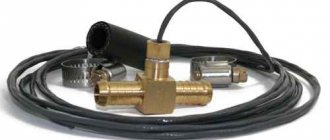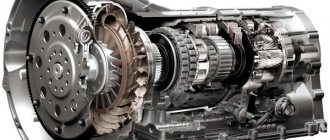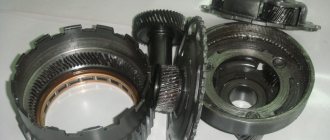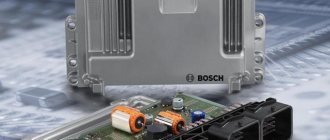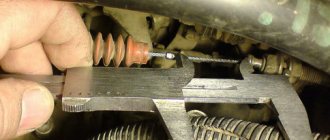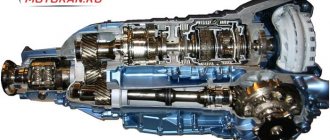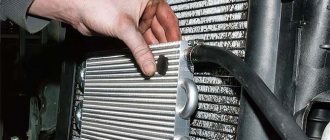Automatic transmission selector position sensor
The machine contains several types of devices that monitor the parameters of the gearbox so that deviations do not occur. When any part breaks or the device fails, it sends a signal to the control panel monitor.
The position sensor consists of resistive plates and a slider that moves.
Attention! The automatic transmission selector position device is a sealed device, which is better not to disassemble, but to replace completely. Since disassembly and reassembly can lead to subsequent system failures. And a hacked inhibitor is difficult to configure to function adequately.
Operating principle of the sensor
The operating principle of the sensor is as follows:
This is how the gear selector position device works. But in addition to its main function, it is responsible for some components of the car. More on this in the next block.
What is the sensor responsible for?
The selector lever position sensor is a multifunctional device. The signal from it turns on the reversing lamps. The inhibitor controls the operation of the starter drive in the “P” and “N” positions. That is why the serviceability of the device is important.
The driving mode is determined using a potentiometer. The resistance of the device depends on the position of the slider. At the same time, the output voltage also changes. And the voltage directly works with the valve body valves, opening or closing them.
Where is it located?
It can be found on the device selector shaft. In most cases it is connected to the spool valve actuator in the hydraulic plate.
Attention! The sensor is opened by drilling out rivets.
Now you know what the device is and how to find it. Next, I will talk about common causes of device malfunctions and point out signs of failure.
In the meantime, write in the comments whether you have already disassembled the automatic transmission selector position sensor or replaced it?
Sensors in the automatic transmission
So, the main task is the smooth operation of the automatic transmission, speed of response, minimizing wear of loaded automatic transmission elements, etc.
Simply put, the electronic system must change gears at the most appropriate moment.
It is quite obvious that to implement such a task it is necessary to take into account a number of individual parameters. For this reason, the automatic transmission control unit is programmed in such a way as to dynamically select the most suitable transmission operating mode, taking into account the readings that are recorded and transmitted by the sensors.
In an automatic transmission, the main sensors are:
- speed sensor. This sensor is necessary to determine the rotation speed of the input and output shaft of the box;
- Automatic transmission oil pressure sensor, transmission fluid temperature sensor;
- automatic transmission selector position sensor, which is also called automatic transmission inhibitor or automatic transmission shift sensor;
- The automatic transmission control unit is closely connected to the ECM of the entire vehicle, which allows it to receive information from other sensors.
The automatic transmission speed sensor is one of the main elements. Often there are two such sensors, one “reads” the speed of rotation of the primary (input) shaft, while the other transmits to the ECU data on the speed of rotation of the output shaft or differential gear on automatic front-wheel drive cars.
As for the automatic transmission ECU, information from the first sensor allows the controller to determine the degree of load on the internal combustion engine and select the most suitable gear. Readings from the second sensor are needed in order to monitor the operation of the gearbox (how the ECU command is executed, whether the desired gear has been engaged, etc.)
If we talk about the speed sensor and its design, such an element is a well-known Hall sensor. Frequent problems include damage to the housing and problems with contacts. However, it will not be possible to quickly check the speed sensor with a multimeter, so during diagnostics it is recommended to install a known-good element.
Let us also add that on some cars you can also find an inductive speed sensor. The sensor works on the principle that when a gear tooth of the gearbox passes through the magnetic field of the sensor, voltage appears in the coil. This voltage forms a signal and is transmitted to the ECU.
The block takes into account the total number of gear teeth, which allows you to calculate the current speed. It is important to understand that the Hall sensor is visually similar to an inductive one, but the second option is very different in operating principle, it generates an analog signal, does not use a reference voltage, etc. By the way, the inductive sensor can be checked with a multimeter.
- The automatic transmission selector position sensor is necessary for the control unit to “switch on” the appropriate operating mode of the box. In other words, this sensor allows the unit to determine how to operate the hydraulic system, taking into account the position of the automatic transmission selector (PNRD-2-1, manual control M +/-, etc.).
Often the specified sensor is called an automatic transmission inhibitor. This sensor is usually located on the gearbox selector shaft. Also, on some automatic transmissions it can be connected to the mode selection spool valve drive in the valve body itself.
The automatic transmission selector position sensor is also responsible for turning on the reversing lights and controls the operation of the starter drive in the selector positions P and N. If we talk about the device, such sensors may differ, but they are often based on a potentiometer that changes the resistance depending on the position there is a selector.
In a nutshell, the sensor consists of resistive plates and a movable slider directly connected to the selector. Taking into account the position of the slider, the resistance of the sensor also changes, which also leads to a change in the output voltage.
As a rule, over time, this sensor may become unusable or begin to work incorrectly. In some cases, disassembling the closed case and carrying out preventive maintenance helps, but after this further malfunctions are possible. For this reason, experts recommend immediately replacing the automatic transmission selector position sensor.
- Temperature and pressure sensors record parameters directly related to ATF. An automatic transmission temperature sensor is necessary because the operation of friction clutches greatly depends on the properties of the working fluid, oil level and temperature.
In simple words, to protect the clutches and gearbox from overheating, a thermistor is installed that can change the resistance when the temperature changes. It turns out that the sensor voltage changes depending on the ATF temperature, and the corresponding signals are transmitted to the ECU.
The automatic transmission temperature sensor is installed in the gearbox housing or integrated into the wiring inside the automatic transmission housing. If, according to sensor readings, the ECU detects significant overheating, the automatic transmission usually goes into emergency mode.
As for the automatic transmission pressure sensor, indicated sensors are usually installed in the valve body channels, measure pressure readings and transmit electrical signals to the automatic transmission electronic control unit. We also recommend reading an article about how an automatic transmission works and works. From this article you will learn about the design and operating principles of a hydromechanical automatic transmission, as well as the design features of the automatic transmission.
Such sensors can be discrete and analog. The first type registers deviations from certain parameters during automatic transmission operation. Normally, the sensor contacts are closed; if the pressure drops at the location of the sensor, the contacts will be open, the ECU receives a signal and increases the pressure.
An analog sensor takes into account changes in pressure more flexibly by sending different signals. This allows the unit to more accurately make the necessary adjustments, affecting the operation of the automatic transmission.
- In the list of sensors that are used to control the automatic transmission, the electronic control unit of the automatic transmission also receives signals from other ECM sensors. For example, the unit receives signals from the brake pedal sensor to lock the selector when turning on the “parking” mode, the accelerator pedal position sensor (if the gas pedal is electronic), the TPS to determine the current load on the internal combustion engine and select the most suitable gear, etc.
Input shaft speed sensor (input speed) automatic transmission: purpose, malfunctions, repair
Among the various sensors that closely interact with the automatic transmission ECU and can cause malfunctions, we should separately highlight the automatic transmission input shaft sensor and the automatic transmission output shaft sensor.
If we are talking about the automatic transmission input speed sensor, its task is to diagnose problems, control gear shift points, adjust operating pressure, and also lock up the torque converter (GDT).
In a nutshell, the sensor transmits readings (DC or AC signals) to the control unit. The voltage signal of this sensor itself is proportional to the speed of rotation of the input shaft of the box.
Signs that the automatic transmission input speed sensor has failed or is not working correctly are a noticeable deterioration in vehicle dynamics, poor and weak acceleration, a “check” light on the instrument panel, or the automatic transmission going into emergency mode.
In such a situation, many drivers believe that the cause is low fuel quality, a malfunction of the engine power system, or contamination of the transmission oil.
It should be taken into account that instead of cleaning the injector or changing the oil in the automatic transmission, in-depth diagnostics of the automatic transmission or checking the speed sensor of the input shaft of the transmission may be necessary.
Signs of breakdown
The vehicle may be completely immobilized as a result of sensor failure. Since it stops receiving data from the components associated with it, in order not to cause harm, the automation turns off all electronics. But this rarely happens.
Most often, if the automatic transmission selector position device breaks down, the following error information appears on the panel screen:
Source
Signs of a broken gear shift sensor
What can cause a sensor to fail? The reason may be abrasion of contacts due to constant use of the lever, or water getting inside due to a leak, especially if the crankcase protection is not installed. If the gear shift sensor fails, the control unit stops receiving information about the position of the selector. There are several signs that the sensor is faulty:
• the “HOLD” light on the dashboard is active, the automatic transmission goes into emergency mode. Turning off the engine and starting it again does not solve the problem.
Read more about what HOLD is in an automatic transmission
• There is only a shift to first speed, there are no other shifts.
Emergency unlocking of automatic transmission
If the engine is faulty or the battery is dead, on many modern cars it is impossible to “reset” the transmission to neutral without starting the engine. You will need an emergency automatic transmission unlock. On almost all cars it is possible to do this yourself. But in some cases you will need the help of professionals. If you could not find the emergency unlock button, then call our roadside assistance specialists from the Evakuator-MSK company. They will promptly come to you, unlock the box and you will be able to load your vehicle onto a tow truck without resorting to the services of a forklift.
Sensor replacement technology
We move the selector lever to “N”, remove everything under the hood that may interfere with access: battery, air filter, etc. We disconnect the rod to the gear selection rod and fix it to avoid spontaneous gear shifting.
Slightly loosen the rod nut, reducing the fit on the shaft. And now, carefully, with swinging to the sides, we remove the rod from the rod. Disconnect the electrical connector of the sensor. We free the sensor body from extraneous “overlays” that prevent its removal. This could be an oil level dipstick guide, an electrical connector casing, etc., it all depends on the design features of the car. Now use the appropriate heads to unscrew the pin and bolt securing the sensor. Rocking from side to side, remove the automatic transmission gear shift sensor . All. The old one is for disposal, the new one is in its place. Assembly is carried out, as you might guess, in the reverse order.
Source
Removing the automatic transmission selector
A selector is used to control the operating mode of the automatic transmission. Rough handling, physical wear, and manufacturing defects can lead to unstable operation of the lever. In order to identify the malfunction, it is necessary to dismantle and disassemble the unit. Using a visual inspection, you can identify oxidized contacts or expired lubricant.
Removing the selector may differ on different car models, but the basic sequence of actions is the same for all. To dismantle the unit you need:
The above instructions on how to remove the selector will allow you to dismantle the assembly without damaging it. The most common mistake in this case is excessive impact on the retaining antennae. The latches are made of fragile material, so they break off with any awkward movement. To securely fasten the pads inside the casing when the antennae break, it is recommended to replace them with new ones.
Disassembling the mechanism
In order to repair the automatic transmission selector, it is necessary to disassemble it after dismantling. To do this, it is recommended to adhere to the following sequence:
Contacts cleaned using zeroing
If the tracks are destroyed, it is better to replace the contact group with a new one. During disassembly, avoid getting debris and abrasive objects inside the selector. If necessary, it is recommended to put marks to facilitate subsequent assembly.
Subtleties of assembly and installation of the selector
When disassembling the contact group, special attention should be paid to lubrication. The smoothness of switching and wear of the contact pair depend on it. Darkening and presence of inclusions are a reason for its replacement.
During operation, native lubricant becomes similar to glue. To eliminate it, use gasoline, kerosene, WD-40 or solvent. It is necessary to clean with a brush, without resorting to excessive pressure that can bend the contact bars.
It is recommended to use silicone lubricants as a replacement. Litol, solid oil and similar consistent materials should not be used. Moisture and small debris quickly accumulate in them. This leads to excessive wear of the selector contact group and the need to frequently intervene in its operation.
When carrying out assembly and installation work, it is recommended to monitor the condition of the heads and threads of the fastening bolts. If they are damaged, it is advisable to replace them with new ones. If you do not do this, it will be difficult to disassemble the unit next time.
Read also: Speed of human decision making

